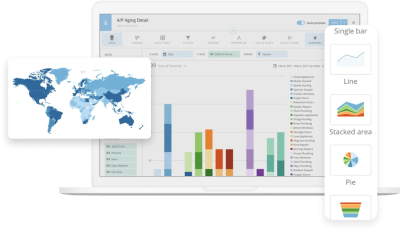Sharing BI dashboards with stakeholders: A guide for optimal collaboration
Collaborating on business intelligence (BI) dashboards can be daunting for any organization.
By sharing data visualizations and analyses with different stakeholders, an organization can optimize its decision-making process and improve communication. But how can you make sure that everyone is on the same page?
In this article, we’ll share some tips on how to effectively share BI dashboards with stakeholders—from design to sharing dashboards among different groups.
Defining dashboard users
When creating BI dashboards, it’s important to keep in mind the needs of the different stakeholders who will be viewing and interacting with them. Each stakeholder group is likely to have its own specific goals and objectives, so the dashboard should be designed accordingly.
For example, upper management might be interested in high-level overviews of the business, while front-line workers might need more detailed data to do their jobs.
There are four main types of stakeholders:
- business users
- power users
- data scientists
- executive decision-makers
Business users are the primary consumers of BI dashboards. They typically want dashboards that are easy to understand and provide them with the information they need to make decisions.
Power users are experienced users of BI tools who want more control over their data and the ability to interact with it.
Data scientists and data analysts often want access to the raw data so that they can perform their own analysis.
Executive decision-makers generally want high-level overviews of the data that show the trends and exceptions. They may not be as interested in the details as other stakeholders.
Once you have considered the different types of stakeholders, you can start to think about how to share BI dashboards effectively. Here are some tips to help you get started:
Establish the requirements: Define the necessary components for a successful dashboard sharing initiative.
The first step is to establish the requirements for sharing BI dashboards. This includes defining who will have access to the dashboards, how often they will be updated, and what level of detail will be included.
It is also essential to consider the different types of devices that stakeholders will use to view the dashboards. Mobile devices, such as smartphones and tablets, have different screen sizes and resolutions than desktop computers. This can impact the way data is displayed and how users interact with the dashboards.
For example, if you want to share BI dashboards with business users, you might consider creating separate versions for mobile and desktop devices. This will ensure that the dashboards are optimized for each platform.

Create a common platform: Choose a platform that is accessible to all stakeholders and easy to use.
Once you have established the requirements, you need to choose a platform for sharing BI dashboards. Many different options are available, such as cloud-based solutions or on-premises software.
The platform most suitable for your organization will depend on a number of factors, such as budget, technical expertise, and the types of devices that stakeholders use.
It is also essential to consider how easy the platform is to use. The last thing you want is for stakeholders to be frustrated with the tool and not use it.
If you are sharing BI dashboards with business users, you might want to consider a cloud-based solution. This will make it easy for them to access the dashboards from anywhere and on any device.
Design an effective dashboard: Structure the dashboard in a way that is easy to understand and use.
The design of your BI dashboards is critical to their effectiveness. The layout, colors, and fonts should be chosen carefully to ensure that the dashboards are easy to understand and use.
It is also important to consider the different types of data that will be displayed on the dashboard. Make sure you choose an appropriate chart for different kinds of data, such as a bar chart for categorical data or a line graph for historical data.
When designing BI dashboards, you should keep the needs of the different stakeholders in mind. Business users might want simple and easy-to-understand dashboards, while data scientists might prefer dashboards that provide more detail.
Implement governance: Establish rules and guidelines for how the dashboards will be used and accessed.
Make sure to establish governance around BI dashboards to ensure that they are used effectively. This includes defining who will have access to the dashboards, how often they will be updated, and what level of detail will be included.
It is also essential to consider how the dashboards will be shared. For example, will they be accessible to everyone in the organization or just a specific group of authorized users?
The governance around BI dashboards should be reviewed on a regular basis to ensure that it is still relevant. This is especially important as the needs of the organization change over time.
Train users: Make sure all users are familiar with how to use and interpret the dashboards.
It is vital to train users on how to interact with and interpret the BI dashboards. This includes providing them with an overview of the different types of data that are available, as well as how to use the filters and controls.

Monitor usage: Keep track of how the dashboards are being used and make changes as needed.
One of the most important aspects of sharing BI dashboards is monitoring usage. This includes tracking how often the dashboards are accessed, which features are being used, and what types of data are being queried.
This data can be used to improve the dashboards over time. For example, if you notice that users are struggling to find specific data, you can make changes to the layout or add new filters.
If you are sharing BI dashboards across a large organization, it is important to consider how usage might differ between different groups of users. When possible, you should create separate dashboards for different types of users.
This will ensure that the dashboards are tailored to their specific needs and that they are being used effectively.
Keep it up to date: Regularly update the dashboards to ensure that they are accurate and reflect the most current data.
Finally, it is important to regularly update the BI dashboards. This includes ensuring that the data is accurate and that the dashboards reflect any changes in the business.
Updating the dashboards regularly will help ensure that they are always relevant and useful to the users. The risks of not updating the dashboards should also be considered, as outdated information can lead to incorrect decisions being made.
What should I look out for as I build my first dashboard?
There are a few key things to keep in mind as you build your first dashboard:
Layout
The layout of the dashboard should be easy to understand and use. The layout should also be consistent across all of the different types of data that are being displayed.
Visualizations
The visualizations on the dashboard should be clear and easy to interpret. They should also be appropriate for the type of data that is being displayed.
Data sources
The data sources for the dashboard should be reliable and accurate. You should also be able to track where the data is coming from and how it has been processed.
Security
The security of the dashboard should be considered. This includes ensuring that only authorized users have access to the dashboard and that the data is secure.
What about sharing dashboards?
Sharing BI dashboards is a great way to improve communication and collaboration within an organization. However, as you share dashboards with different stakeholders, it is important to consider how they will be used and accessed.
Sharing dashboards effectively starts with understanding the needs of the users. Once you understand the users well, you can tailor the dashboards to their specific needs.
Check out some related resources:

Cloud Data Warehouse Usage Surges 116% as Industries Race to the Cloud

8 Best AI Tools for Data Visualization






